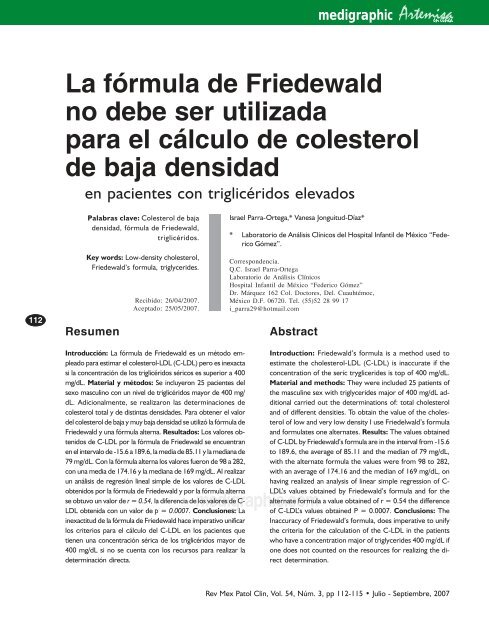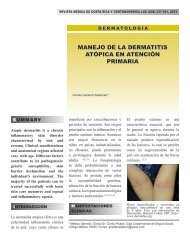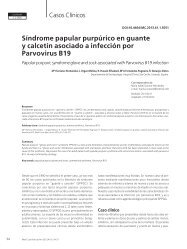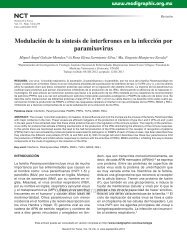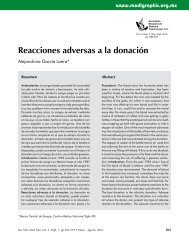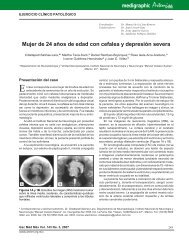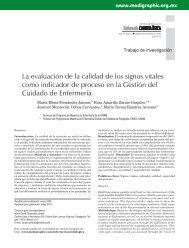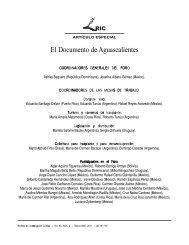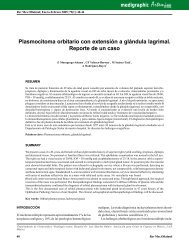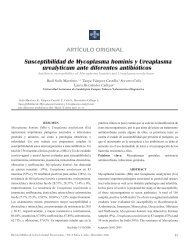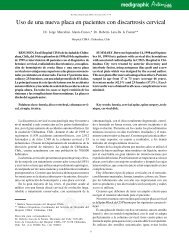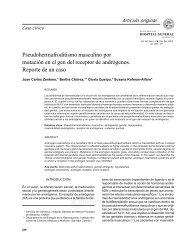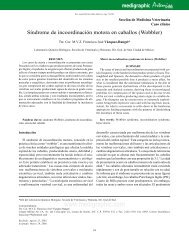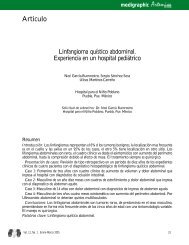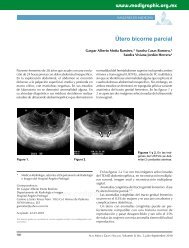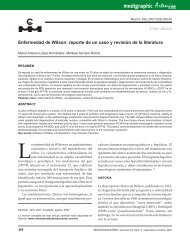La fórmula de Friedewald no debe ser utilizada ... - edigraphic.com
La fórmula de Friedewald no debe ser utilizada ... - edigraphic.com
La fórmula de Friedewald no debe ser utilizada ... - edigraphic.com
You also want an ePaper? Increase the reach of your titles
YUMPU automatically turns print PDFs into web optimized ePapers that Google loves.
m<strong>edigraphic</strong><br />
Artemisa<br />
en línea<br />
<strong>La</strong> <strong>fórmula</strong> <strong>de</strong> Frie<strong>de</strong>wald<br />
<strong>no</strong> <strong>de</strong>be <strong>ser</strong> <strong>utilizada</strong><br />
para el cálculo <strong>de</strong> colesterol<br />
<strong>de</strong> baja <strong>de</strong>nsidad<br />
en pacientes con triglicéridos elevados<br />
112<br />
Palabras clave: Colesterol <strong>de</strong> baja<br />
<strong>de</strong>nsidad, <strong>fórmula</strong> <strong>de</strong> Frie<strong>de</strong>wald,<br />
triglicéridos.<br />
Key words: Low-<strong>de</strong>nsity cholesterol,<br />
Frie<strong>de</strong>wald’s formula, triglyceri<strong>de</strong>s.<br />
Resumen<br />
Recibido: 26/04/2007.<br />
Aceptado: 25/05/2007.<br />
Israel Parra-Ortega,* Vanesa Jonguitud-Díaz*<br />
* <strong>La</strong>boratorio <strong>de</strong> Análisis Clínicos <strong>de</strong>l Hospital Infantil <strong>de</strong> México “Fe<strong>de</strong>rico<br />
Gómez”.<br />
Correspon<strong>de</strong>ncia.<br />
Q.C. Israel Parra-Ortega<br />
<strong>La</strong>boratorio <strong>de</strong> Análisis Clínicos<br />
Hospital Infantil <strong>de</strong> México “Fe<strong>de</strong>rico Gómez”<br />
Dr. Márquez 162 Col. Doctores, Del. Cuauhtémoc,<br />
México D.F. 06720. Tel. (55)52 28 99 17<br />
i_parra29@hotmail.<strong>com</strong><br />
Abstract<br />
Introducción: <strong>La</strong> <strong>fórmula</strong> <strong>de</strong> Frie<strong>de</strong>wald es un método empleado<br />
para estimar el colesterol-LDL (C-LDL) pero es inexacta<br />
si la concentración <strong>de</strong> los triglicéridos séricos es superior a 400<br />
mg/dL. Material y métodos: Se incluyeron 25 pacientes <strong>de</strong>l<br />
sexo masculi<strong>no</strong> con un nivel <strong>de</strong> triglicéridos mayor <strong>de</strong> 400 mg/<br />
dL. Adicionalmente, se realizaron las <strong>de</strong>terminaciones <strong>de</strong><br />
colesterol total y <strong>de</strong> distintas <strong>de</strong>nsida<strong>de</strong>s. Para obtener el valor<br />
<strong>de</strong>l colesterol <strong>de</strong> baja y muy baja <strong>de</strong>nsidad se utilizó la <strong>fórmula</strong> <strong>de</strong><br />
Frie<strong>de</strong>wald y una <strong>fórmula</strong> alterna. Resultados: Los valores obtenidos<br />
<strong>de</strong> C-LDL por la <strong>fórmula</strong> <strong>de</strong> Frie<strong>de</strong>wald se encuentran<br />
en el intervalo <strong>de</strong> -15.6 a 189.6, la media <strong>de</strong> 85.11 y la mediana <strong>de</strong><br />
79 mg/dL. Con la <strong>fórmula</strong> alterna los valores fueron <strong>de</strong> 98 a 282,<br />
con una media <strong>de</strong> 174.16 y la mediana <strong>de</strong> 169 mg/dL. Al realizar<br />
un análisis <strong>de</strong> regresión lineal simple <strong>de</strong> los valores <strong>de</strong> C-LDL<br />
obtenidos por la <strong>fórmula</strong> <strong>de</strong> Frie<strong>de</strong>wald y por la <strong>fórmula</strong> alterna<br />
se obtuvo un valor <strong>de</strong> r = 0.54, la diferencia <strong>de</strong> los valores <strong>de</strong> C-<br />
LDL obtenida con un valor <strong>de</strong> p = 0.0007. Conclusiones: <strong>La</strong><br />
inexactitud <strong>de</strong> la <strong>fórmula</strong> <strong>de</strong> Frie<strong>de</strong>wald hace imperativo unificar<br />
los criterios para el cálculo <strong>de</strong>l C-LDL en los pacientes que<br />
tienen una concentración sérica <strong>de</strong> los triglicéridos mayor <strong>de</strong><br />
400 mg/dL si <strong>no</strong> se cuenta con los recursos para realizar la<br />
<strong>de</strong>terminación directa.<br />
m<strong>edigraphic</strong>.<strong>com</strong><br />
Introduction: Frie<strong>de</strong>wald’s formula is a method used to<br />
estimate the cholesterol-LDL (C-LDL) is inaccurate if the<br />
concentration of the <strong>ser</strong>ic trygliceri<strong>de</strong>s is top of 400 mg/dL.<br />
Material and methods: They were inclu<strong>de</strong>d 25 patients of<br />
the masculine sex with triglyceri<strong>de</strong>s major of 400 mg/dL additional<br />
carried out the <strong>de</strong>terminations of: total cholesterol<br />
and of different <strong>de</strong>nsities. To obtain the value of the cholesterol<br />
of low and very low <strong>de</strong>nsity I use Frie<strong>de</strong>lwald’s formula<br />
and formulates one alternates. Results: The values obtained<br />
of C-LDL by Frie<strong>de</strong>wald’s formula are in the interval from -15.6<br />
to 189.6, the average of 85.11 and the median of 79 mg/dL,<br />
with the alternate formula the values were from 98 to 282,<br />
with an average of 174.16 and the median of 169 mg/dL, on<br />
having realized an analysis of linear simple regression of C-<br />
LDL’s values obtained by Frie<strong>de</strong>wald’s formula and for the<br />
alternate formula a value obtained of r = 0.54 the difference<br />
of C-LDL’s values obtained P = 0.0007. Conclusions: The<br />
Inaccuracy of Frie<strong>de</strong>wald’s formula, does imperative to unify<br />
the criteria for the calculation of the C-LDL in the patients<br />
who have a concentration major of triglyceri<strong>de</strong>s 400 mg/dL if<br />
one does <strong>no</strong>t counted on the resources for realizing the direct<br />
<strong>de</strong>termination.<br />
Rev Mex Patol Clin, Vol. 54, Núm. 3, pp 112-115 • Julio - Septiembre, 2007
Parra-Ortega I y col. Cálculo <strong>de</strong> colesterol <strong>de</strong> baja <strong>de</strong>nsidad en triglicéridos elevados<br />
D<br />
Introducción<br />
es<strong>de</strong> su <strong>de</strong>scripción se co<strong>no</strong>ce que la <strong>fórmula</strong><br />
<strong>de</strong> Frie<strong>de</strong>wald, método empleado para estimar<br />
el colesterol-LDL (C-LDL) es inexacta si la<br />
concentración <strong>de</strong> los triglicéridos séricos se encuentra<br />
por arriba <strong>de</strong> 400 mg/dL y que la exactitud<br />
<strong>de</strong>l cálculo es ina<strong>de</strong>cuada por arriba <strong>de</strong> 200<br />
mg/dL. 1,2<br />
Debido a la relativa cercanía entre las metas<br />
<strong>de</strong>l panel <strong>de</strong> tratamiento <strong>de</strong>l adulto (ATP III-<br />
NCEP), 3 pequeños errores en la estimación <strong>de</strong>l<br />
C-LDL pue<strong>de</strong>n resultar en que se indique innecesariamente<br />
un fármaco o <strong>no</strong> se prescriba, cuando<br />
en realidad se pue<strong>de</strong> alcanzar un beneficio adicional<br />
con su empleo. 3-5<br />
En un estudio realizado en 355 pacientes, 6 i<strong>de</strong>ntificamos<br />
que 23% con <strong>no</strong>rmoglicemia presentaron<br />
una concentración <strong>de</strong> triglicéridos mayor <strong>de</strong><br />
200 mg/dL y que la frecuencia aumenta en los<br />
pacientes con alteraciones en el metabolismo <strong>de</strong><br />
la glucosa hasta 48.9%, utilizando una <strong>fórmula</strong> alterna<br />
re<strong>com</strong>endada para estimar el C-LDL. En<br />
pacientes con triglicéridos elevados 2-6 la frecuencia<br />
<strong>de</strong> discrepancia con la <strong>fórmula</strong> <strong>de</strong> Frie<strong>de</strong>wald<br />
fue <strong>de</strong> 1.6% en pacientes <strong>no</strong>rmoglicémicos y en<br />
hiperglicémicos <strong>de</strong> hasta 12.9%, dicha discrepancia<br />
está dada principalmente porque la <strong>fórmula</strong><br />
alterna <strong>no</strong> involucra a los triglicéridos en la <strong>de</strong>terminación<br />
<strong>de</strong> C-LDL, hecho que <strong>no</strong> ocurre en la<br />
<strong>fórmula</strong> <strong>de</strong> Frie<strong>de</strong>wald.<br />
Si <strong>no</strong> consi<strong>de</strong>ramos el valor <strong>de</strong> los triglicéridos<br />
me<strong>no</strong>r <strong>de</strong> 200 mg/dL <strong>com</strong>o punto <strong>de</strong> corte<br />
para el cálculo <strong>de</strong>l colesterol LDL por la<br />
<strong>fórmula</strong> <strong>de</strong> Frie<strong>de</strong>wald, 1-6 estaremos proporcionando<br />
valores falsos <strong>de</strong> C-LDL en casi 40% <strong>de</strong><br />
la población y a<strong>de</strong>más esta frecuencia se incrementa<br />
en pacientes con alteraciones <strong>de</strong> los valores<br />
<strong>de</strong> glucosa.<br />
En un informe previo 1 se <strong>de</strong>mostró, en pacientes<br />
sa<strong>no</strong>s, la inexactitud <strong>de</strong>l cálculo <strong>de</strong>l C-LDL<br />
utilizando la <strong>fórmula</strong> <strong>de</strong> Frie<strong>de</strong>wald versus <strong>de</strong>terminación<br />
directa con un método enzimático.<br />
m<strong>edigraphic</strong>.<strong>com</strong><br />
Existe información que sugiere un cambio en la<br />
forma <strong>de</strong> obtención <strong>de</strong>l C-LDL en pacientes con<br />
un valor <strong>de</strong> triglicéridos mayor <strong>de</strong> 200 mg/dL. 6-8<br />
Material y métodos<br />
Se incluyeron 25 pacientes <strong>de</strong>l sexo masculi<strong>no</strong> con<br />
una concentración sérica <strong>de</strong> triglicéridos mayor<br />
<strong>de</strong> 400 mg/dL en una <strong>de</strong>terminación basal con 12<br />
horas <strong>de</strong> ayu<strong>no</strong>, y adicionalmente se realizaron<br />
las <strong>de</strong>terminaciones <strong>de</strong> colesterol total y <strong>de</strong> alta<br />
<strong>de</strong>nsidad.<br />
Para la <strong>de</strong>terminación <strong>de</strong> colesterol total y <strong>de</strong><br />
colesterol <strong>de</strong> alta <strong>de</strong>nsidad (HDL) el método analítico<br />
que se utilizó fue el <strong>de</strong> oxidación selectiva y<br />
para los triglicéridos el enzimático.<br />
Para obtener el valor <strong>de</strong>l colesterol <strong>de</strong> baja y<br />
muy baja <strong>de</strong>nsidad se utilizó la <strong>fórmula</strong> <strong>de</strong> Frie<strong>de</strong>wald<br />
1,2 y también una <strong>fórmula</strong> alterna propuesta.<br />
3,6 Para los pacientes con triglicéridos con una<br />
concentración igual o mayor <strong>de</strong> 200 mg/dL el C-<br />
LDL se calculó <strong>de</strong> la siguiente manera: C-LDL =<br />
Colesterol total – HDL – 30.<br />
Resultados<br />
A los 25 pacientes se les realizó el cálculo <strong>de</strong><br />
C-LDL con las dos <strong>fórmula</strong>s propuestas, los resultados<br />
<strong>de</strong>tallados se encuentran en el cuadro I.<br />
Los valores obtenidos <strong>de</strong> C-LDL por la <strong>fórmula</strong><br />
<strong>de</strong> Frie<strong>de</strong>wald se encuentran en el intervalo <strong>de</strong><br />
-15.6 a 189.6, la media <strong>de</strong> 85.11 y la mediana <strong>de</strong><br />
79 mg/dL. Con la <strong>fórmula</strong> alterna los valores fueron<br />
<strong>de</strong> 98 a 282, con una media <strong>de</strong> 174.16 y la<br />
mediana <strong>de</strong> 169 mg/dL.<br />
Al realizar un análisis <strong>de</strong> regresión lineal simple<br />
<strong>de</strong> los valores <strong>de</strong> C-LDL obtenidos por la <strong>fórmula</strong><br />
<strong>de</strong> Frie<strong>de</strong>wald y los valores obtenidos por la<br />
<strong>fórmula</strong> alterna se obtuvo un valor <strong>de</strong> r = 0.54<br />
(figura 1).<br />
<strong>La</strong> diferencia <strong>de</strong> los valores <strong>de</strong> C-LDL obtenida<br />
en ambas <strong>fórmula</strong>s es estadísticamente significativa<br />
p = 0.0007.<br />
113<br />
Rev Mex Patol Clin, Vol. 54, Núm. 3, pp 112-115 • Julio - Septiembre, 2007
Parra-Ortega I y col. Cálculo <strong>de</strong> colesterol <strong>de</strong> baja <strong>de</strong>nsidad en triglicéridos elevados<br />
Cuadro I. Características <strong>de</strong> los 25 pacientes estudiados.<br />
Paciente Triglicéridos mg/dL COLT mg/dL HDL mg/dL C-LDL FW mg/dL C-LDL-NHDL mg/dL<br />
114<br />
1 403 165 37 47.4 98<br />
2 421 251 40 126.8 181<br />
3 422 307 33 189.6 244<br />
4 425 169 31 53.0 108<br />
5 426 248 49 93.8 169<br />
6 426 215 36 113.8 149<br />
7 430 217 33 98.0 154<br />
8 437 260 37 135.6 193<br />
9 445 288 32 167.0 226<br />
10 450 195 26 79.0 139<br />
11 456 228 29 107.8 169<br />
12 462 171 26 52.6 115<br />
13 462 298 38 167.6 230<br />
14 502 197 27 69.6 140<br />
15 553 258 36 111.4 192<br />
16 597 255 37 98.6 188<br />
17 637 235 29 78.6 176<br />
18 645 198 29 40.0 139<br />
19 672 231 32 64.6 169<br />
20 729 248 28 74.2 190<br />
21 746 189 24 15.8 135<br />
22 889 233 33 22.2 170<br />
23 971 345 33 117.8 282<br />
24 1063 218 21 -15.6 167<br />
25 1212 289 28 18.6 231<br />
COLT: colesterol total, HDL: colesterol <strong>de</strong> alta <strong>de</strong>nsidad, C-LDL FW: colesterol <strong>de</strong> baja <strong>de</strong>nsidad calculado con la <strong>fórmula</strong> <strong>de</strong> Frie<strong>de</strong>wald, C-<br />
LDL-NHDL colesterol <strong>de</strong> baja <strong>de</strong>nsidad calculado con la <strong>fórmula</strong> alterna.<br />
Fórmula <strong>de</strong> Frie<strong>de</strong>wald<br />
200<br />
150<br />
100<br />
50<br />
0<br />
0<br />
50 100 150 200 250 300<br />
Fórmula alterna<br />
Figura 1. Análisis <strong>de</strong> regresión lineal simple <strong>de</strong> los valores<br />
<strong>de</strong> C-LDL obtenidos por la <strong>fórmula</strong> <strong>de</strong> Frie<strong>de</strong>wald y los valores<br />
obtenidos por la <strong>fórmula</strong> alterna, r = 0.54.<br />
m<strong>edigraphic</strong>.<strong>com</strong><br />
Conclusiones<br />
Es evi<strong>de</strong>nte la inexactitud <strong>de</strong> la <strong>fórmula</strong> <strong>de</strong> Frie<strong>de</strong>wald<br />
DOCUMENTO en el cálculo <strong>de</strong>l ES C-LDL ELABORADO en el grupo <strong>de</strong><br />
ESTE<br />
POR pacientes MEDIGRAPHIC<br />
estudiados. Es una aberración que al<br />
utilizar dicha <strong>fórmula</strong> el resultado <strong>de</strong> C-LDL sea<br />
un valor negativo (-15.6 mg/dL), <strong>com</strong>o sucedió<br />
con un paciente y es indudable que la alta concentración<br />
<strong>de</strong> triglicéridos es la causa (1,063 mg/dL).<br />
Existen informes en los que se hace énfasis en<br />
las limitaciones <strong>de</strong> dicha <strong>fórmula</strong>. 6-9 Si <strong>no</strong> consi<strong>de</strong>ramos<br />
<strong>com</strong>o una limitante el valor <strong>de</strong> los triglicéridos<br />
para el cálculo <strong>de</strong>l colesterol LDL por la<br />
<strong>fórmula</strong> <strong>de</strong> Frie<strong>de</strong>wald estaremos proporcionando<br />
valores falsos <strong>de</strong> C-LDL en aproximadamente<br />
Rev Mex Patol Clin, Vol. 54, Núm. 3, pp 112-115 • Julio - Septiembre, 2007
Parra-Ortega I y col. Cálculo <strong>de</strong> colesterol <strong>de</strong> baja <strong>de</strong>nsidad en triglicéridos elevados<br />
40% <strong>de</strong> los pacientes y el porcentaje se incrementa<br />
en pacientes con diabetes. 10-15<br />
El valor <strong>de</strong>l C-LDL <strong>no</strong> <strong>de</strong>be obtenerse a partir<br />
<strong>de</strong> una <strong>fórmula</strong> matemática con un alto porcentaje<br />
<strong>de</strong> error. <strong>La</strong>s metodologías analíticas re<strong>com</strong>endadas<br />
para dicha <strong>de</strong>terminación son la ultracentrifugación<br />
y la cromatografía líquida <strong>de</strong> alta<br />
resolución (HPLC). 17-20<br />
<strong>La</strong> inexactitud <strong>de</strong> la <strong>fórmula</strong> <strong>de</strong> Frie<strong>de</strong>wald hace<br />
imperativo unificar los criterios para el cálculo <strong>de</strong>l<br />
C-LDL en los pacientes que tienen concentración<br />
sérica <strong>de</strong> triglicéridos mayor <strong>de</strong> 400 mg/dL, si <strong>no</strong><br />
se cuenta con los recursos para realizar la <strong>de</strong>terminación<br />
directa.<br />
Referencias<br />
1. Garzón GG. Análisis <strong>de</strong> la <strong>fórmula</strong> <strong>de</strong> Frie<strong>de</strong>wald y su aplicación,<br />
a través <strong>de</strong> la <strong>com</strong>paración <strong>de</strong> los valores <strong>de</strong> C-LDL obtenidos<br />
por <strong>de</strong>terminación enzimática y mediante la <strong>fórmula</strong> en pacientes<br />
sa<strong>no</strong>s. Contacto Químico 2006; 3: 4-5.<br />
2. Rijks LG. Frie<strong>de</strong>wald formula. Clin Chem 1995; 41: 761.<br />
3. National Cholesterol Education Program Expert Panel. Executive<br />
summary of the third report of the National Cholesterol<br />
Education Program (NCEP). Expert panel on <strong>de</strong>tection, evaluation,<br />
and treatment of high blood cholesterol in adults (Adult<br />
Treatment Panel III). JAMA 2001; 285: 2486-2497.<br />
4. Drexel H, Aczel S, Marte T, Benzer W, <strong>La</strong>nger P, Moll W, Saely<br />
CH. Is atherosclerosis in diabetes and impaired fasting glucose<br />
driven by elevated LDL cholesterol or by <strong>de</strong>creased HDL cholesterol?<br />
Diabetes Care 2005; 28:101-107.<br />
5. Samman S, Truswell AS. The Frie<strong>de</strong>wald equation for the <strong>de</strong>termination<br />
of low-<strong>de</strong>nsity-lipoprotein cholesterol: a special case.<br />
Am J Clinical Nutrition 1993: 58; 928.<br />
6. García AH, Estrada ML, Estrada GRA, Jonguitud DV, Parra OI.<br />
El valor <strong>de</strong>l colesterol <strong>de</strong> baja <strong>de</strong>nsidad (C-LDL) en pacientes<br />
con triglicéridos elevados, estudio en una población seleccionada.<br />
Med Int Mex 2007 (En Prensa).<br />
7. Warnick GR, K<strong>no</strong>pp RH, Fitzpatrick V, Branson L. Estimating<br />
low-<strong>de</strong>nsity lipoprotein cholesterol by the Frie<strong>de</strong>wald equation<br />
is a<strong>de</strong>quate for classifying patients on the basis of nationally<br />
re<strong>com</strong>men<strong>de</strong>d outpoints. Clin Chem 1990; 36: 15-19.<br />
8. Li KM, Wilcken DE, Dudman NP. Effect of <strong>ser</strong>um lipoprotein(a)<br />
on estimation of low-<strong>de</strong>nsity lipoprotein cholesterol by the Frie<strong>de</strong>wald<br />
formula. Clin Chem 1994; 40: 571-573.<br />
9. Ridker PM, Rifai N, Cook NR, Bradwin G, Buring JE. Non–HDL<br />
cholesterol, apolipoproteins A-I and B100, standard lipid<br />
measures, lipid ratios, and CRP as risk factors for cardiovascular<br />
disease in women. JAMA 2005; 294: 326-333.<br />
10.Wägner AM, Sánchez QJL, Pérez A, Rigla M, Cortés M, Blanco<br />
VF, Ordóñez LJ. Inaccuracy of calculated LDL-cholesterol in<br />
type 2 diabetes: consequences for patient risk classification and<br />
therapeutic <strong>de</strong>cisions. Clin Chem 2000: 46; 1830-1832.<br />
11.Samman S, Truswell AS. The Frie<strong>de</strong>wald equation for the <strong>de</strong>termination<br />
of low-<strong>de</strong>nsity-lipoprotein cholesterol: a special case<br />
Am J Clinical Nutrition 1993; 58: 928.<br />
12.Warnick GR, K<strong>no</strong>pp RH, Fitzpatrick V, Branson L. Estimating<br />
low-<strong>de</strong>nsity lipoprotein cholesterol by the Frie<strong>de</strong>wald equation<br />
is a<strong>de</strong>quate for classifying patients on the basis of nationally<br />
re<strong>com</strong>men<strong>de</strong>d outpoints. Clin Chem 1990; 36: 15-19.<br />
13.Sacks FM, Tonkin AM, Craven, Pfeffer MA, Shepherd J, Keech<br />
A, Furberg CD, Braunwald E. Coronary heart disease in<br />
patients with low LDL-Cholesterol: benefit of pravastatin in<br />
diabetics and enhanced role for HDL-cholesterol and triglyceri<strong>de</strong>s<br />
as risk factors. Circulation 2002; 105: 1424-1428.<br />
14.The expert <strong>com</strong>mittee on the diag<strong>no</strong>sis and classification of<br />
diabetes mellitus. follow-up report on the diag<strong>no</strong>sis of diabetes<br />
mellitus. Diabetes Care 2003; 26(11): 3160-3167.<br />
15.Rui J, Matthias BS, Tricia Li, Na<strong>de</strong>r R, Meir JS et al. Non-HDL<br />
cholesterol and apolipoprotein B predict cardiovascular disease<br />
events among men with type 2 diabetes. Diabetes Care 2004:<br />
27; 1991-1997.<br />
16.Senti M, Pedro-Botet J, Nogues X, Rubies-Prat J. Influence of<br />
intermediate-<strong>de</strong>nsity lipoproteins on the accuracy of the Frie<strong>de</strong>wald<br />
formula. Clin Chem 1991; 37: 1394-1397.<br />
17.Matthias N, Russell WG, Na<strong>de</strong>r R. Methods for measurement<br />
of LDL-cholesterol: a critical assessment of direct measurement<br />
by homogeneous assays versus calculation. Clin Chem 2002;<br />
48: 236-254.<br />
18.Shinichi U, Hajime K, Motoi O, Yuki M, Mitsuyo O. Differential<br />
reactivity of two homogeneous LDL-cholesterol methods to<br />
LDL and VLDL subfractions, as <strong>de</strong>monstrated by ultracentrifugation<br />
and HPLC. Clin Chem 2002; 48: 1946-1954.<br />
19.Schectman G, Patsches M, Sasse EA. Variability in cholesterol<br />
measurements: <strong>com</strong>parison of calculated and direct LDL cholesterol<br />
<strong>de</strong>terminations. Clin Chem 1996; 42: 732-737.<br />
20. Li KM, Wilcken DE, Dudman NP. Effect of <strong>ser</strong>um lipoprotein(a)<br />
on estimation of low-<strong>de</strong>nsity lipoprotein cholesterol by the Frie<strong>de</strong>wald<br />
formula. Clin Chem 1994; 40: 571-573.<br />
115<br />
m<strong>edigraphic</strong>.<strong>com</strong><br />
Rev Mex Patol Clin, Vol. 54, Núm. 3, pp 112-115 • Julio - Septiembre, 2007


